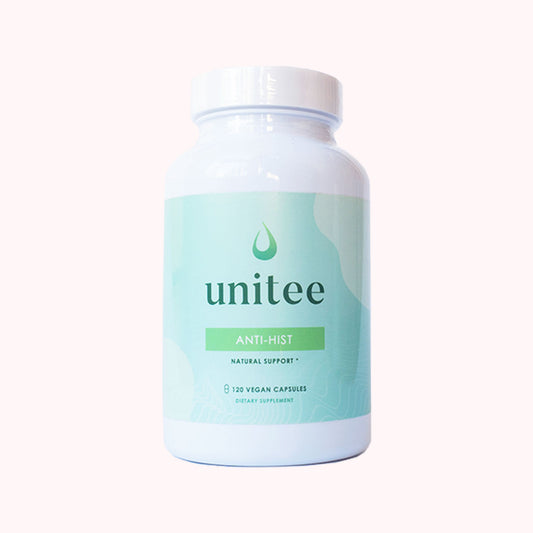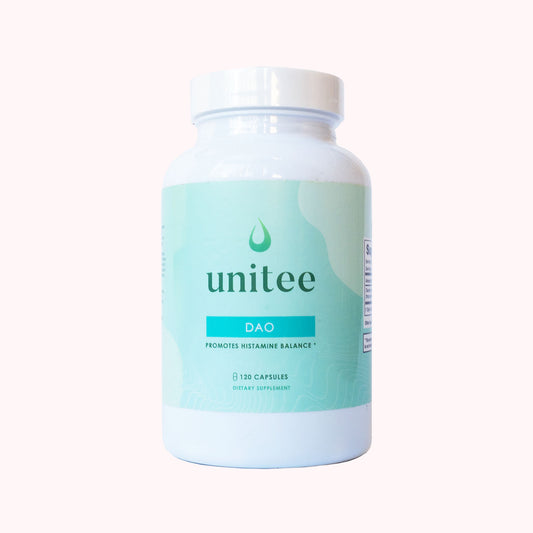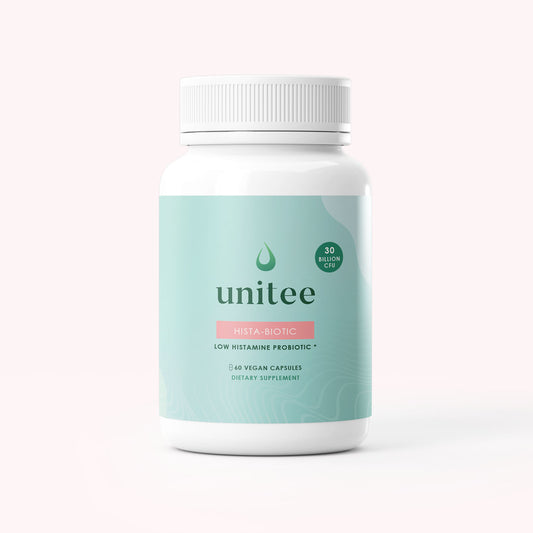Are you struggling to manage your histamine symptoms?
Well... have you ever heard about oxalates?
Are you histamine intolerant and have previously or currently:
- had a problem with candida in the past;
- taken a lot of antibiotics in your life;
- had difficulty digesting fat in your diet; or
- had your gallbladder removed?
Are you also finding it difficult to manage your symptoms overall, having significant flare ups and dealing with a lot of discomfort, despite following a low histamine diet and making sure you’re keeping up with all of the right histamine-related advice?
It’s time to listen up! Your body could be struggling with a common co-intolerance: oxalates.
What are oxalates?
You may or may not have heard of oxalates before, but they certainly are being spoken about more and more, especially in the natural health community.
Why? Well, just like histamines, they are compounds found in plant foods that can be troublesome for many people, particularly in those who are already dealing with intolerances or imbalances of other kinds.
So, what are oxalates?
While they sound somewhat exotic, they are actually quite simple, and are compounds that are protective to plants. Just like histamine, oxalates are usually not an issue for humans, that is, if your digestive system works as it should.
It’s when you’re used to dealing with microbial imbalances associated with candida, regular antibiotic use, or you're having unexplained digestive issues, that oxalates can begin to cause problems.
Oxalate intolerance symptoms
The biggest issue is that when oxalates don’t get processed and eliminated correctly they can bind to minerals in the digestive system and be absorbed into the body through the digestive tract. They can enter the tissues and cause all sorts of problems because they just don’t belong there.
In fact, it’s their structure that becomes the most damaging in the tissues, and they’re quite jagged and spiky in their appearance, often being referred to as being like shards of glass. That’s why, when clients come to us with lots of digestive symptoms, and they also suffer from chronic pain, we start asking specific questions along the oxalate intolerance route.
Pain is a significant symptom when it comes to oxalate overload. It is commonly associated with all sorts of arthritis pain, feeling like you’re constantly inflamed, have been diagnosed with fibromyalgia, have bladder pain or problems, and suffer from chronic headaches or migraines.
As you can see, some of these oxalate intolerance symptoms cross over with histamine intolerance symptoms - however, if you're not getting them under control simply from a low histamine diet, it's incredibly important to consider that many individuals have co-intolerances. Oxalate intolerance is one of the most common co-intolerances that occurs alongside histamine intolerance.
Having an oxalate intolerance does not mean you should stop your histamine intolerance therapies - it unfortunately means that you may have further restrictions and additional therapies than someone with just histamine intolerance.
For example, you can consider if someone had a histamine intolerance alongside a gluten intolerance, they may have additional symptoms and may need to work to manage their gluten intolerance with alternative therapies and dietary modifications. On the other hand, someone with histamine intolerance alone may be able to indulge in gluten here and there without additional symptoms and while only focusing on histamine intolerance therapies.
Another key symptom to consider in oxalate intolerance is kidney stones. As mentioned above, they like to bind to calcium, and crystalized calcium is the biggest offender when it comes to kidney stones. If you have a history of kidney stones, the words calcium oxalate stones may ring a bell! It’s these oxalates binding together along with calcium clogging up your kidneys.
Fortunately, there is a way for you to manage the oxalate levels in your body and bring about balance in both histamine and oxalate levels.
How to manage histamine and oxalate levels
Keep in mind, you're going to want to remain on a low histamine diet - however, we're going to add an extra layer to that. The low histamine diet is your starting point, which you can click below to get:
Now, we're going to add another very important step here...
Unlike histamine intolerance and many other intolerances, simply cutting oxalates from your diet and going full steam ahead on a low oxalate diet overnight is not a good idea. The reason being is that the lower your oxalate levels become, the more oxalates are allowed to move from your tissues, on their way out to be eliminated. Now, this may sound like a great idea, but remember what oxalates look like. They’re pointy and sharp, and their movement through the body can be extremely painful if it happens too rapidly.
So before you even consider starting a low oxalate diet, know this: it needs to be done slowly, and I recommend you take at least 2 weeks to reduce your intake of the offending oxalate foods I am going to mention below, as you transition gradually to a low oxalate diet on top of your low histamine diet.
Fortunately, many of the oxalate-containing foods such as avocado, spinach, chocolate and tomato are also histamine containing, so you’re likely already cutting many of them out. It’s also important to mention that if you suffered considerably while going cold turkey low histamine, the oxalate movement could have been the culprit. In other words, depending on what foods you were focusing on, you may have gone on a low oxalate diet (or lower oxalate diet than before) without realizing.
Despite having cut many oxalates out already, there are a couple more foods you need to consider. They could very well be ones that might currently be staples in your low histamine diet, but that are keeping your body loaded full of oxalates.
The first, and biggest offender for a low oxalate diet is potatoes. While sweet potatoes are considerably lower in oxalates than other varieties, it’s best to remove all varieties over the two week elimination period.
Other veggies you want to keep an eye on during your low oxalate diet include beets, steamed vegetables especially broccoli and Brussel sprouts, carrots, and rhubarb. Another common high oxalate food is wheat. This may be surprising, but consider how many people feel that they are gluten-intolerant? They may not have a problem with gluten at all, but the oxalates in wheat itself.
Many berries are also higher in oxalates. Blackberries and raspberries are particularly high and should be eliminated on a low oxalate diet. Other foods to consider which are high in oxalates include grains like millet, herbs like oregano, spices like turmeric, nuts like cashews, hazelnuts, peanuts, pune nuts, pistachios, and macadamia nuts, as well as seeds like sesame and then foods that contain soy and stevia.
You’re probably wondering what you can eat on a low oxalate diet. You’d be surprised, but there is quite a lot! And, it’s important to know that oxalates aren’t to be banished forever. Many of you simply need to complete your healing journey and you’ll likely be able to tolerate moderate amongst again, just like histamines.
Over the next two weeks, focus on lots of green leafy vegetables (Bok Choy, brussel sourpurs, cabbage, cauliflower, cucumber, rapini, cauliflower and celery). Eat these well cooked, not steamed or raw. For carbs you can add squash, rice, and gluten-free oats and for a little bit of sweetness, opt for fruit like mangoes, lychees, honeydew melon, red delicious apples, green grapes and peeled pears.
All animal foods are generally considered safe on a low oxalate diet, however, at this point continue to take into account those that are higher in histamines. Generally, poultry, good quality frozen fish and non-aged beef can be eaten without issue.
While most nuts and seeds are both high in histamines and oxalates, you’ll be safe consuming pumpkin seeds, which are highly nutritious and can be ground into a delicious butter, too.
Lastly, consider flavoring your food with herbs and spices that are low in both histamines and oxalates to increase the appeal. Ginger, cilantro, sage, rosemary and basil are great options that are low oxalate foods and also cover the low histamine foods category.
Give this low oxalate diet on top of your current histamine intolerance protocol a go for a good two weeks and see if your symptoms improve. If they do, have a small amount of oxalate containing food again to see if your symptoms come back. They shouldn’t be as dramatic as before, but you’ll definitely feel some effects if oxalates are a problem!
You can then focus more on your healing journey, getting your gut working optimally again, and can then get back to eating both a moderate amount of healthy histamines and oxalate containing food.
The commonality of a few additional intolerances alongside histamine intolerance why the How I Solved My Histamine Intolerance Course takes into account modifications for those with oxalate intolerance or other common intolerances. This consideration allows you to progress through the program in order to address your histamine intolerance issues while also pertaining to any additional intolerances you may be experiencing.
Wishing you the best of health.
Anita Tee, Nutritional Scientist
References:
- Wigner, P., et al. Probiotics in the Prevention of the Calcium Oxalate Urolithiasis. Cells 2022, 11(2), 284
- Garland V, Herlitz L, Regunathan-Shenk R. Diet-induced oxalate nephropathy from excessive nut and seed consumption. BMJ Case Reports CP 2020;13:e237212.
- Sabatino, J. A., Starin, D., Tuchman, S., Ferreira, C., & Regier, D. S. (2019). Elevated urine oxalate and renal calculi in a classic galactosemia patient on soy‐based formula. JIMD Reports, 49(1), 7–10.
- Mitchell T, Kumar P, Reddy T, Wood KD, Knight J, Assimos DG, Holmes RP. Dietary oxalate and kidney stone formation. Am J Physiol Renal Physiol. 2019 Mar 1;316(3):F409-F413.
- Khan SR. Reactive oxygen species, inflammation and calcium oxalate nephrolithiasis. Transl Androl Urol. 2014 Sep 1;3(3):256-276.

Anita Tee
My name is Anita Tee. I'm a nutritional scientist specializing in histamine intolerance. I hold a Master of Science in Personalized Nutrition and a Bachelor of Science in Human Biology and Psychology.
For the past ten years, I have used my experience in nutritional and medical health sciences to create a scientifically backed, natural approach to healthcare that relies 100% on evidence-based research.
As I previously suffered from - and overcame - histamine intolerance, my focus is to increase recognition and expand the available resources and protocols for resolving the disorder. To date, I have helped over 4,000 individuals fully resolve or better manage their histamine intolerance symptoms.







